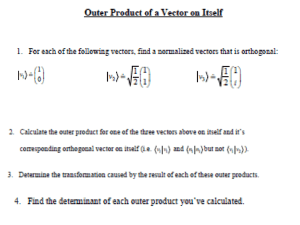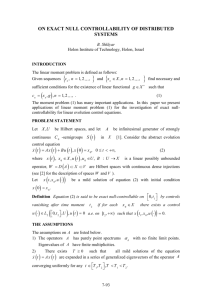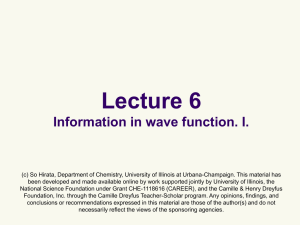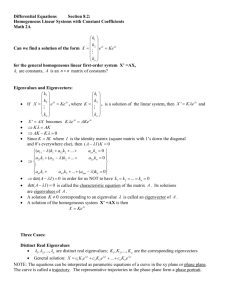Lecture 11
advertisement
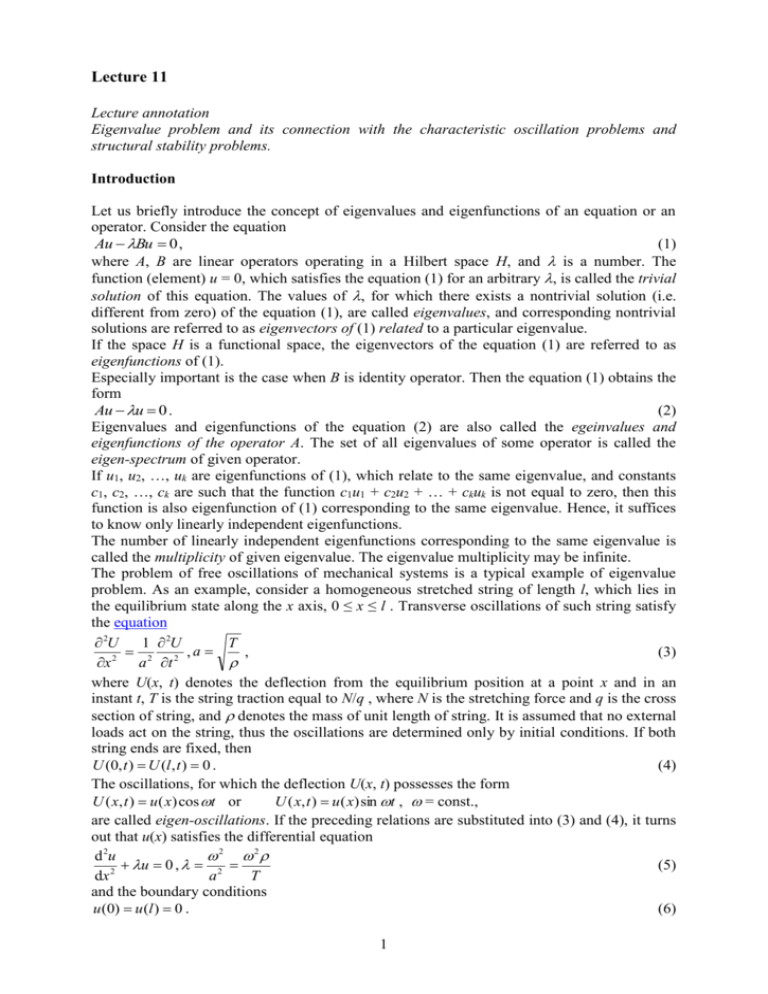
Lecture 11
Lecture annotation
Eigenvalue problem and its connection with the characteristic oscillation problems and
structural stability problems.
Introduction
Let us briefly introduce the concept of eigenvalues and eigenfunctions of an equation or an
operator. Consider the equation
(1)
Au Bu 0 ,
where A, B are linear operators operating in a Hilbert space H, and is a number. The
function (element) u = 0, which satisfies the equation (1) for an arbitrary , is called the trivial
solution of this equation. The values of , for which there exists a nontrivial solution (i.e.
different from zero) of the equation (1), are called eigenvalues, and corresponding nontrivial
solutions are referred to as eigenvectors of (1) related to a particular eigenvalue.
If the space H is a functional space, the eigenvectors of the equation (1) are referred to as
eigenfunctions of (1).
Especially important is the case when B is identity operator. Then the equation (1) obtains the
form
(2)
Au u 0 .
Eigenvalues and eigenfunctions of the equation (2) are also called the egeinvalues and
eigenfunctions of the operator A. The set of all eigenvalues of some operator is called the
eigen-spectrum of given operator.
If u1, u2, …, uk are eigenfunctions of (1), which relate to the same eigenvalue, and constants
c1, c2, …, ck are such that the function c1u1 + c2u2 + … + ckuk is not equal to zero, then this
function is also eigenfunction of (1) corresponding to the same eigenvalue. Hence, it suffices
to know only linearly independent eigenfunctions.
The number of linearly independent eigenfunctions corresponding to the same eigenvalue is
called the multiplicity of given eigenvalue. The eigenvalue multiplicity may be infinite.
The problem of free oscillations of mechanical systems is a typical example of eigenvalue
problem. As an example, consider a homogeneous stretched string of length l, which lies in
the equilibrium state along the x axis, 0 ≤ x ≤ l . Transverse oscillations of such string satisfy
the equation
T
2U
1 2U
,a
,
(3)
2
2
2
x
a t
where U(x, t) denotes the deflection from the equilibrium position at a point x and in an
instant t, T is the string traction equal to N/q , where N is the stretching force and q is the cross
section of string, and denotes the mass of unit length of string. It is assumed that no external
loads act on the string, thus the oscillations are determined only by initial conditions. If both
string ends are fixed, then
U (0, t ) U (l , t ) 0 .
(4)
The oscillations, for which the deflection U(x, t) possesses the form
U ( x, t ) u ( x) cos t or
U ( x, t ) u ( x) sin t , = const.,
are called eigen-oscillations. If the preceding relations are substituted into (3) and (4), it turns
out that u(x) satisfies the differential equation
d 2u
2 2
u 0 , 2
(5)
dx 2
a
T
and the boundary conditions
u (0) u (l ) 0 .
(6)
1
It follows from physical considerations that u(x) ≠ 0. If it be to the contrary, the string would
not oscillate at all. Thus, the free oscillation problem for a string is reduced to the eigenvalue
problem for the operator– d2/dx2 with the boundary conditions (6). If the string is
inhomogeneous, then is a function of x, = (x). In this case, the eigen-oscillation problem
leads to the same boundary conditions (6), and to the equation
d 2u
(7)
( x)u 0 .
dx 2
In this case however, = 2T. The equation (7) is a special case of (1), in which A = −d2/dx2
and B is the operator, which corresponds to the multiplication by the function (x). Both
operators are defined for functions that equal to zero at the string ends.
Next, investigate the eigen-oscillations of membrane. If the membrane is not subjected to
external loads, the equation for transverse oscillations has the form
2U 2U 1 2U
(8)
U 2 2 2 2 .
x
y
a t
In the equilibrium, let the membrane occupy the domain of xy plane, with the boundary S.
If the membrane is fixed at the boundary, then
(9)
U S 0.
The eigen-oscillations of the membrane have the form
U ( x, y, t ) u ( x, y ) cos t
U ( x, y, t ) u ( x, y ) sin t .
or
This leads to the integration of differential equation
u u 0 ,
2
(10)
a2
in the domain with the boundary condition
(11)
u S 0.
Since u(x, y) ≠ 0, the problem is reduced to searching eigenvalues and eigenfunctions of the
operator −with the boundary condition (11).
Another class of problems that lead to the solution of eigenvalue problem concerns the
stability of mechanical systems. It will be explained using the following example:
Consider the deflection of a plate subjected to in-plane loading proportional to some
parameter . Let this loading generates stresses Tx, Txy, Ty. Transverse loading does not
exist and the plate boundary is clamped. The plate deflection satisfies the homogeneous
differential equation (because transverse loading q(x, y) ≡ 0)
h 2 w
2w
2w
2
(12)
w
Tx
2Txy
Ty 2 0
D x 2
xy
y
and homogeneous boundary conditions
w
(13)
0.
wL 0,
n L
The system of equations (12), (13) has trivial solution. This indicates that the undeflected
plate is an equilibrium state. If is sufficiently small, i.e.
CD
,
(14)
2 Nh
where N denotes max(Tx, Txy, Ty), then the trivial solution is a single solution, and thus the
undeflected shape of the plate is unique. Simultaneously it is obvious that sufficiently small
changes of do not disturb the inequality (14), and thus they do not disturb the undeflected
equilibrium shape of the plate, which will be stable with respect to small changes of the
parameter . If does not satisfy the inequality (14), it may happen that for some values of ,
called critical ones, the equation (12) will have a nontrivial solution, which fulfils the
boundary conditions (13). It this case, in addition to undeflected shape of the plate, also
2
deflected (buckled) shape may occur. When approaches the critical value, the undeflected
shape of the plate turns to be instable.
Apparently, it is important to find critical values of the parameter (especially the lowest
critical value), which is, in principle, the eigenvalue problem for the equation (12) with
boundary conditions (13).
It may be generally stated that the stability problem reduces to the eigenvalue problem for a
linear equation whereas the nonlinear equations, describing given problem, form a starting
point of analysis.
Eigenvalues and eigenfunctions of symmetric operator
Theorem 1. Symmetric operator has real eigenvalues.
Let 0 be an eigenvalue and 0 be corresponding eigenfunction of symmetric operator A. Then
it holds
A0 00 .
Multiply the preceding equality by0 to form the scalar product and get
( A0 ,0 )
0
.
(15)
2
0
The operator A is symmetric, hence (A0, 0) = (0, A0). At the same time it holds (0, A0)
= ( A0 ,0 ) (property of the scalar product). The number (A0,0) is equal to its complex
conjugate, thus it is a real number. According to (15), 0 is a real number.
Remark 1. Eigenvalues of a positive and a positive definite operator are positive numbers. It follows
immediately from the relation (15) (Further we will consider only real spaces with respect to eigenvalue
problems).
Theorem 2. Eigenfunctions of symmetric operator corresponding to different eigenvalues are
mutually orthogonal.
Let 1, 2 be distinct eigenvalues of the symmetric operator A. Let 1, 2 be corresponding
eigenfunctions. Then
(16)
A1 11 , A2 22 .
Multiply scalarly the first equation by 1 and the second equation by 2. Subtract both
equations and obtain
( A1,2 ) (1, A2 ) (1 2 )(1,2 ) .
The left-hand side of the preceding equation is equal to zero because the A is symmetric.
Hence, if 1 − 2 ≠ 0, it must hold (1, 2) = 0.
If more eigenfunctions belong to a given eigenvalue, these eigenfunctions can be
orthogonalized using Schmidt’s orthogonalization process. Thus, in the next, we will assume
that the set of eigenfunctions of symmetric operator forms an orthonormal system.
Theorem 3. Eigenfunctions of a positive operator are orthogonal according to energy.
Let 1 be an eigenvalue and 1 be an eigenfunction of the positive operator A so that
(17)
A1 11
and let 2 ≠ 1 be another eigenfunction of the same operator. According to the previous
assumptions, 1, 2 are orthogonal in ordinary sense, i.e. (1, 2) = 0. If the equation (17) is
scalarly multiplied by 2, we get (A1, 2) = 0, which completes the proof.
3
Remark 2. It happens quite often that the system of eigenfunctions is not only orthogonal but also complete
according to energy. Hence, such system can be used to construct the solution of the equation
(18)
Au f
in the form of the orthogonal series expansion.
Let the system of eigenfunctions of a positive definite operator be complete according to
energy. Besides, it is clear that this system is orthonormal also in ordinary sense. Denote by
n, n = 1, 2, …, the eigenfunctions of the operator A and n are corresponding eigenvalues (if
more eigenfunctions belong to the same eigenvalue, some of the numbers n will be
indentical); then it holds
0, n m,
[ m , n ] 0 ,
A n n n .
( n , m )
n m,
1, n m,
If the last equality is scalarly multiplied by n, we get
2
( A n , n ) n n .
(19)
The equation (19) shows that the functions n are not orthonormal according to energy. If we
denote
n
n
,
n
(20)
we get the system of functions, which are orthonormal according to energy and the system is,
according to the presumption, complete according to energy.
Energetic theorems for eigenvalue problems
Eigenvalue problem can be reduced under specified conditions to a certain variational
problem. Let the symmetric operator A satisfies the inequality
2
( Au, u ) k u ,
(21)
where k is a real number, which need not be necessary positive. Such operator is called
bounded below. Specially, every positive operator is bounded below because it satisfies the
inequality (21) for k = 0.
If A is the operator bounded below, then (Au, u)/(u, u) ≥ k. If the value (Au, u)/(u, u) is
bounded below, it has a infimum d. Obviously, d ≥ k. We prove following theorems:
Theorem 5. Let A be operator bounded below and let d be infimum of values of the functional
( Au, u )
.
(22)
(u, u )
If there exists a function u0 DA such that
( Au0 , u 0 )
d,
(23)
(u 0 , u 0 )
then d is the lowest eigenvalue of the operator A and u0 is the corresponding eigenfunction.
Proof. Let be an arbitrary function from the domain of definition DA and t is an arbitrary
real number. The function of real variable t
( A(u0 t ), u0 t ) t 2 ( A , ) 2t ( Au0 , ) ( Au0 , u0 )
(t )
(u0 t , u0 t )
t 2 ( , ) 2t (u0 , ) (u0 , u0 )
attains its minimum for t = 0. Then, however, '(0) = 0. If we calculate '(0), we easily obtain
the equation
(u0 , u0 )( Au0 , ) ( Au0 , u0 )(u0 , ) 0 ,
or, when we use the equation (23), we get
( Au0 du0 , ) 0 .
(24)
4
The set DA is dense in basic Hilbert space, and it follows from (24) that Au0 − du0 = 0, i.e. d is
the eigenvalue and u0 is the eigenfunction of the operator A.
The fact, that d is the lowest eigenvalue of the operator A, follows from the relation (15).
Indeed, if 1 is an eigenvalue and u1 is a corresponding eigenfunction of the operator A, then
( Au1 , u1 )
( Au, u )
1
min
d.
(25)
(u1 , u1 )
(u , u )
Using the theorem 5, the eigenvalue problem for symmetric operator, bounded below, is
reduced to the problem of searching a function that minimizes the functional (22).
This problem can be reformulated in a more suitable form. Let = u/||u||. Then
1
and
( Au, u )
(26)
( A , ) .
(u, u )
Replace again by the letter u. Our variational problem can now be stated as follows: Find
the minimum of the functional
( Au, u ) ,
(27)
subject to restriction
(u , u ) 1 .
(28)
Now we show how to find other eigenvalues.
Theorem 6. Let 1 ≤ 2 ≤ … ≤ n be first n successive eigenvalues of the symmetric operator
A, bounded below, and u1, u2, …, un are corresponding orthonormal eigenfunctions. Let there
exist a function u = un + 1 ≠ 0 minimizing the functional (22) subject to subsidiary conditions
(29)
(u, u1 ) 0, (u, u2 ) 0 , … (u, un ) 0 .
Then un + 1 is the eigenfunction of the operator A which corresponds to the eigenvalue
( Aun1 , u n1 )
n1
(30)
(u n1 , u n1 )
This eigenvalue is the nearest successive eigenvalue of n.
Proof. Let be an arbitrary function from the domain of definition DA of the operator A. Let
n
( , u k )u k
k 1
Then satisfies the conditions (29). Indeed,
n
( , u m ) ( , u m ) ( , u k )(u k , u m ) ,
m 1, 2, , n .
(31)
k 1
According to the presumption, the functions uk are orthonormal. Therefore
0, k m
(u k , u m )
1, k m
and thus
( , um ) ( , um ) ( , um ) 0 .
Together with , also the product t satisfies the conditions 29), where t is an arbitrary
number. Thus, also the sum un + 1 + t satisfies (29). The function of variable t
( A(u n1 t ), u n1 t )
(u n1 t , u n1 t )
attains a minimum for t = 0. If we repeat the same considerations that were used in the proof
of the theorem 5 we found that
( Aun1 n1un1 , ) 0 .
(32)
Focus to the expression
5
( Aun1 n1un1 , ) .
According to the relations (31) and (32) it holds
( Aun1 n1u n1 , )
n
( Aun1 n1u n1 , ) (u k , )( Aun1 n1u n1 , u k )
k 1
n
(u k , )( Aun1 n1u n1 , u k ).
k 1
Further,
( Aun1 n1un1 , uk ) ( Aun1 , uk ) n1 (un1 , uk ) .
It can be shown without difficulty that the last expression equals to zero. Indeed, the second
term on the right-hand side drops out using the conditions (29). The first term equals to
( Aun 1 , uk ) (un 1 , Auk ) .
However, uk, as an eigenfunction of the operator A, satisfies the equation Auk = uk. Thus
( Aun 1 , uk ) k (un 1 , uk ) 0 .
It follows form there that
( Aun 1 n 1un 1 , ) 0 ,
where is an arbitrary function of the dense set DA, hence Aun + 1 – n+1un + 1 = 0, i.e. n + 1 is
an eigenvalue and un + 1 is a corresponding eigenfunction. It remains to prove that n + 1 is the
lowest eigenvalue following the eigenvalue n. Let ’ be an eigenvalue of the operator A,
larger than n and u’ is a corresponding eigenfunction. According to the theorem 6, it fulfils
the conditions (29). Further, according to the relation (15) it holds
( Au' , u ' )
'
n 1 ,
(u ' , u ' )
since n + 1 is the minimum of the functional (27) subject to conditions (29). Similarly as in the
case of the lowest eigenvalue, the problem of finding n+1 can be reduced to the variational
problem: Find the minimum of the functional (7) subject to subsidiary conditions (28) and
(29).
The previous theorems have a relative character − they describe the method of construction of
eigenvalues, if their existence is proved in another way. Here, we introduce a theorem that
sets down the existence conditions of eigenvalues of positive definite operator.
Theorem 7. Let A be positive definite operator, which operates in the Hilbert space H. Let
every set of functions bounded according to energetic norm is compact in H. Then the
operator A
a) has infinite number of eigenvalues
n n
0 1 2 n ,
b) corresponding eigenfunctions form a complete set both in H and in HA.
Ritz method in the eigenvalue problem
Let A be the operator bounded below, hence
2
( Au, u ) k u .
The eigenvalue problem for the operator A can easily be reduced to the eigenvalue problem
for a positive definite operator. Indeed, let c be an arbitrary number larger | k |. The equation
Au u 0 ,
which defines eigenvalues of the operator A, can be rewritten in the form
~
~
Au u 0 ,
~
~
~
where A u = Au + cu, = + c. The operator A is positive definite because
6
~
2
( A u, u ) ( Au, u ) c(u , u ) (c k ) u
~
~
and c + k > 0. If is an eigenvalue of the operator A , then = – c is an eigenvalue of the
operator A and vice versa. Hence, in what follows we will always assume that A is positive
definite operator. Let
( Au, u )
.
(33)
d inf
uD A (u , u )
According to the theorem 5, d is the lowest eigenvalue of the operator A, if there exists such a
function u0, so that
( Au0 , u0 )
d
.
(u0 , u0 )
If we assume that such function exits, then the problem of finding the lowest eigenvalue of the
operator A can be reduced to searching a minimum of the functional (33), or, searching a
minimum of the functional
( Au, u )
(34)
subject to restriction
(u , u ) 1 .
(35)
We show that this problem can be solved by means of the Ritz method. Consider the sequence
of base functions n, n = 1, 2, …, which possess the following three properties:
1. n DA, n = 1, 2, …;
2. for arbitrary n, the functions 1, 2, …, n are linearly independent;
3. the system{n} is complete according to energy.
Let
n
u n ak k ,
k 1
where ak are arbitrary coefficients. We choose these coefficients such that un satisfies the
relation (35) and the product (Aun, un) attains a minimum. Hence, it requires to find a
minimum of the function of n variables
( Aun , un )
n
( A ,
k , m 1
k
m
(36)
)ak am
with subsidiary condition
(un , un )
n
( ,
k , m 1
k
m
)ak am 1 .
(37)
The problem will be solved using the method of Lagrange multipliers. Set up the function =
(Aun, un) – (un, un), where is yet unknown coefficient, and the partial derivatives of with
respect to am are set equal to zero. Obtain the set of equations
n
a [( A ,
k 1
k
k
m
) ( k , m )] 0 ,
m = 1, 2, …, n.
(38)
The system (38) is linear and homogeneous with respect to am, not all of which can be equal
to zero (because the equation (37) would not hold any longer). Therefrom it follows that the
determinant of (38) must equal to zero. It provides the equation determining
( A1 ,1 ) (1 ,1 ) ( A2 ,1 ) (2 ,1 ) ( An ,1 ) (n ,1 )
( A1 ,2 ) (1 ,2 ) ( A2 ,2 ) (2 ,2 ) ( An ,2 ) (n ,2 )
( A1 ,n ) (1 ,n ) ( A2 ,n ) (2 ,n ) ( An ,n ) (n ,n )
0.
When the sequence {n} is orthonormal, the equation (39) simplifies to the form
7
(39)
( A1 ,1 )
( A2 ,1 )
( A1 ,2 )
( A2 ,2 )
( A1 ,n )
( A2 ,n )
( An ,1 )
( An ,2 )
( An ,n )
0
(40)
As it was stated, the functions 1, 2, …, n are linearly independent for arbitrary n. Then the
equation (39) is exactly of n-th degree, since the coefficient at (–1)nn is Gram’s determinant
of functions 1, 2…,n. Therefrom it follows that the equation (39) has just n roots. Let ak( 0 ) ,
k = 1, 2, …, n, be also a solution. Then ak( 0 ) , where is an arbitrary coefficient, also satisfies
the system (38). If ak( 0 ) is substituted into (37), the value of can be found. If now the notation
ak( 0 ) is replaced by ak( 0 ) , we can further understand ak( 0 ) as a solution of the system (38),
which satisfies the equation (37). When = 0 and ak = ak( 0 ) is substituted in(38) we get the
equality as
n
n
a
k 1
(0)
k
( A k , m ) 0 ak( 0 ) ( k , m ) ,
m = 1, 2, …, n.
(41)
k 1
Multiply (41) by ak( 0 ) and sum with respect to m. Get
n
( Ak ,m )ak(0)am(0) 0
k , m 1
n
( ,
k , m 1
k
m
)ak( 0) am(0) .
(42)
It follows from the equation (37) that the right-hand side of (42) is equal to 0. The left-hand
side of (42) is equal to (A uk( 0 ) , uk( 0 ) ), where
n
uk( 0 ) ak( 0 ) k .
k 1
Hence
0 ( Aun( 0) , un( 0) ) .
(43)
The formula (43) shows, that the equation (39) has only real roots if the operator A is
symmetric. Further, one of the functions un( 0 ) minimizes the expression (36). Hence, the
relation (43) eventually shows that this minimum is equal to the lowest of the roots of
equation (39).
Now, we will deal with the determination of subsequent eigenvalues. To obtain an
approximate value of the second eigenvalue, we will seek a minimum of of the product (36)
subject to subsidiary conditions (un, un) = 1 and
(un( 0) , un )
n
( ,
k
k , m 1
where un( 0)
n
a
k , m 1
m
)ak(0) am 0 ,
(44)
k stands for the approximation of the first normalised eigenfunction of
( 0)
k
the operator A. According to the method of Lagrange multipliers set up the expression
( Aun , un ) (un , un ) 2 (un , un( 0 ) )
and its partial derivatives with respect to ak set equal to zero. Obtain the system
a [( A ,
n
k 1
k
k
m
) ( k , m )] ( k , m )ak( 0 ) 0 ,m = 1, 2, …, n.
(45)
Both sides of (45) multiply by ak( 0 ) and sum with respect to m:
n
(0)
(0) (0)
a
a
[(
A
,
)
(
,
)]
a
a
(
,
)
km
k m k m 0.
k
m
k
m
k , m 1
k , m 1
n
8
(46)
The second summation can be shown that equals to (un( 0 ) , un( 0 ) ) 1 . In the first summation,
interchange the subscripts m and k , and firstly sum with respect to k and then with respect to
m. The first summation takes the form
n
n
m 1
k 1
am ak(0)[( Am ,k ) (m ,k )] .
(47)
The inner sum equals to
n
a
k 1
(0)
k
[( k , A m ) ( k , m )] ,
or, since A is symmetric operator,
n
a
k 1
(0)
k
[( A k , m ) ( k , m )] .
Applying the equations (38), which the numbers ak( 0 ) must satisfy for = (n0 ) , the last
expression provides
n
n
((n0) ) ak( 0) (k ,m ) ((n0) ) ak( 0)k ,m
k 1
k 1
(0)
(0)
(0)
( 0)
(n )(un ,m ) (n )(m , un ).
The expression (47) takes then the form
n
((n0 ) ) am (m , un( 0) ) ((n0 ) )(un , un( 0 ) ) ,
k 1
which, according to (44), equals to zero. It follows now from (45) that = 0 and the system
(45) is equivalent to the system (38). Therefrom we infer (as previously) that the searched
minimum is equal to , which is the root of the equation (39). Obviously, in this case, we
need to choose the second root (if they are sized up) of the mentioned equation.
Analogously, we can construct subsequent approximate eigenvalues. All are roots of the
equation (39).
Remark 3. Any of the weighed residual procedures can also be employed to compute eigenvalues.
Problems
1. For the fixed-hinged column compute buckling loads. Use the Ritz method and
compare an approximate result with the exact value. The governing differential
equation for column axially loaded by compressive force N0 is EIw N 0 w 0 .
9


